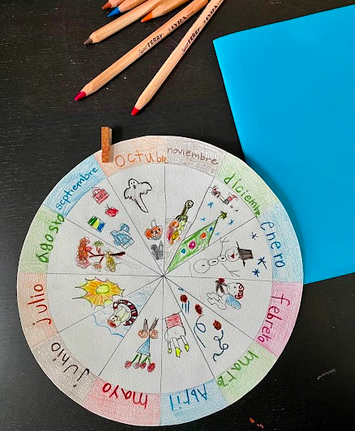Class 2 World Language
Students in second grade may enroll in Spanish and/or German at Lotus & Ivy. Students in many brick and mortar Waldorf schools take two languages, other than their native language, each year beginning in first grade until they select one language for in-depth study beginning in 7th grade. Our class size is 14 students, allowing the teacher to get to know each student and creating a class community environment during class.
One of the striking features of the first Waldorf School, founded by Rudolf Steiner in Stuttgart in 1919, was that all pupils from Class 1 up were taught two foreign languages. Prior to that, foreign language learning in German schools (starting in Class 5) had been the privilege of those children belonging to middle and upper class families. What reasons did Rudolf Steiner give for introducing foreign languages for all children at this unprecedented, early age? These were certainly very different from the pragmatic reasons for teaching and learning foreign languages which have become increasingly important in society throughout the decades since then.
The encounter with other languages should not only serve to extend the individual’s horizon in a formal manner, it should also enrich and diversify his inner life, nurturing his very soul. It was vital, so Steiner maintained, to introduce languages other than one’s own as a means of counteracting whatever one-sided influence any particular language exerted on the developing child. By getting to name and recognize the objects in the world around him in a new way through the medium of a foreign language, every child would be given the opportunity to break free from the confines of his mother tongue. Education of this kind would prevent children from growing up into narrow-minded, nationalistically prejudiced adults. Instead of encouraging attitudes that ultimately separate people and nations from one another, tolerance and mutual understanding between nations should be consciously cultivated.
Spanish with Ms. Straubel
Lotus & Ivy offers two opens for Spanish for each grade-level.
Option 1: Students may attend Spanish two days a week for a more frequent yearly study. This option will cover more of the curriculum, about twice as much, compared to Option 2.
Option 2: Students may attend Spanish one day a week for a weekly lesson.
During class time, Lotus & Ivy Spanish students follow a daily and weekly rhythm that includes poetry, bodily movements, songs, grammar & vocabulary lessons, games, and artistic response that will complement the main lesson curriculum.
In Story Time the teacher reads an authentic children’s Spanish storybook—engaging students’ imagination and reinforcing language concepts.
In Art Time students complete an art project which gives them a hands-on, practical application of language concepts. During Art Time the teacher engages students one-on-one and converses with them in Spanish about what they’re working on—further reinforcing language concepts.
Students then practice language concepts, with independent reading and writing for older students.
In general, our Spanish lessons are themed according to Waldorf-inspired main lessons for an integrated approach. If your student is new to Spanish studies, Ms. Straubel is able to differentiate the curriculum so no one feels left behind.
German with Ms. DiPasquali
METHODICAL APPROACH
Rudolf Steiner gave various indications about the way children could be introduced to world languages in the first three years of school. The single most important suggestion is probably that the children should encounter the new language in a direct way, i.e., not through translation, but by “matching the words with the objects”. At the time, this was quite a revolutionary approach, but in the course of the 20th century, it gained almost universal acceptance for the teaching of world languages to children of this age (‘Direct Method’). As far as concrete objects are concerned, this is definitely the most obvious approach. The children’s mother tongue should, as a general rule, be reserved for “emergency situations”, e.g. when a child has hurt himself, when a quarrel among two pupils needs to be settled or for other urgent matters of classroom discipline.
Just as children, while learning their mother tongue, proceed from pointing and moving to actually saying things, such purposeful movement plays a very important part in learning a second language in the Lower School. Teachers will try to find as many opportunities as possible for the children to move and actually do things, both in response to simple commands, as is done in what is now called Asher’s Total Physical Response, and along with the teacher in verses and songs. The emphasis for the children then will be on the activity itself rather than on language learning. This coincides with what more recently has become known as Natural Second Language Acquisition.
“Language is best taught when it is being used to transmit messages, not when it is explicitly taught for conscious learning.” In a similar vein, Rudolf Steiner said the children should be trained in the ability to have little conversations about everyday life in the foreign language [“sachliches Konversieren”]. This includes topics like classroom objects, family, pets, the weather, food, etc.
Poetic language, based on rhythm and rhyme, is learned far more easily by children than is prose language. Along with singing, poetic language introduces the children to the flow of the new language and also familiarizes them with its prosodic/paraverbal elements: emphasis, intonation, pitch, etc. or, more generally speaking, with that part of human speech which is not expressed by the contents of the words.
Poetic language, by contrast, requires the children to be patient and prepared to listen inwardly and to realise that understanding may be a process that takes time. When we manage to give the children, on the one hand, enough language that is easily understood and, on the other, a reasonable amount that “demands patience”, they gradually learn to feel their way into understanding the meaning of even complex poetic forms and structures without these being mentioned. Understanding is prompted by emotion and empathy. Playing games is an important part of language lessons in the Lower School.
They should have a special place in every Lower School language teacher’s repertoire, not just because the children like them more than other activities, but because they offer a unique way of enticing the children to speak the language. The child focuses on the action, not on speaking or on groping for words, and the enjoyment of active participation in a language game removes any inhibitions a particular child might have.
VARIETY OF METHODS
Apart from the professional qualifications and skills of the teacher, the classroom as a social framework is probably the decisive factor for the success or failure of language lessons in the Lower School. As teachers, we are the source of the new language for the children when we recite an action rhyme or introduce a comprehension exercise, counting-out rhyme, finger-play, new game or singing-game. Our aim will always be to engage the pupils in such a way that they feel it is their own effort that matters most of all.
On this occasion, it also makes sense for the language teacher to ask the parents very clearly not to interfere with what their children are learning at school, i.e. not to correct them if they reproduce something from their language lessons at home and there are mistakes in it. It is much better for the children to get these straightened out at school. Also, the parents should be reminded that, for the child, the new language is very closely linked to the school environment (their own classroom, the presence of their teacher and their classmates etc.). Asking a child to say things at home in the world language completely alone often leads to feelings of insecurity and sometimes even to downright refusal.
Sometimes we are asked by parents why the written language is introduced as late as Class 4. The reasons for this are twofold: From a developmental perspective, the child passes through an important phase between his ninth and tenth year. He slowly begins to distance himself from his surroundings and to perceive people and objects around him in a new light. So this is the right time to introduce the written mode in world language teaching.
The other reason is to allow children the time to build up a large “treasure” of poems, stories, etc. in the course of the first three classes, thus having at their disposal a suitable body of language and activities that can be used in the first steps of handling the written word. The next stage, from writing to reading, is immensely facilitated when the first texts that the children get to read are somewhat familiar.
What if my child is coming to Lotus & Ivy during the later years, but has never had German instruction?
If your student is new to German studies, as many of our students are, no worries! Ms. Di Pasquali is able to differentiate the curriculum so no one feels left behind and everyone receives an enriching experience. Each class will be individualized for the experience of the group. For example, If one child already speaks German, they will receive additional challenges while the rest of the class learns the basics.



